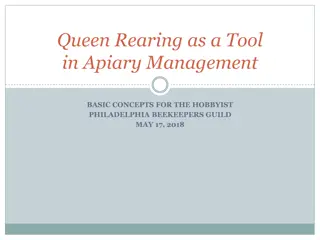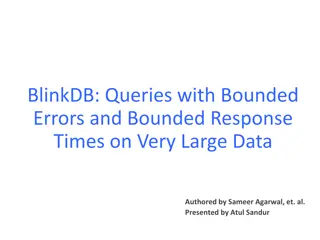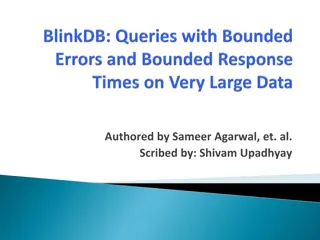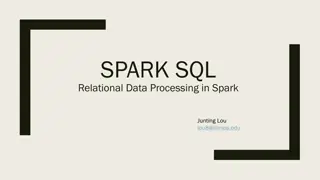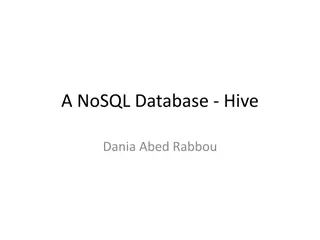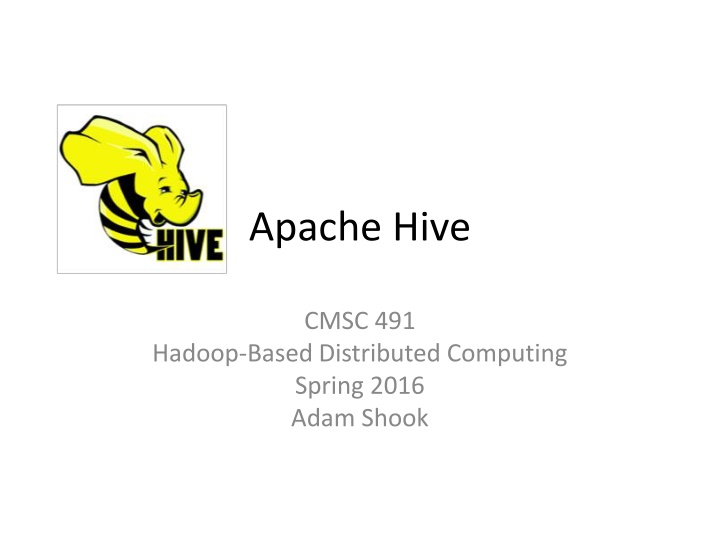
Apache Hive: A Powerful Hadoop-Based Data Processing Tool
Learn about Apache Hive, a data warehousing infrastructure built on Hadoop that enables easy data summarization, ad-hoc querying, and analysis of large datasets using SQL-like queries via HiveQL. Explore its data hierarchy, HiveQL operations, primitive, and complex data types.
Download Presentation

Please find below an Image/Link to download the presentation.
The content on the website is provided AS IS for your information and personal use only. It may not be sold, licensed, or shared on other websites without obtaining consent from the author. If you encounter any issues during the download, it is possible that the publisher has removed the file from their server.
You are allowed to download the files provided on this website for personal or commercial use, subject to the condition that they are used lawfully. All files are the property of their respective owners.
The content on the website is provided AS IS for your information and personal use only. It may not be sold, licensed, or shared on other websites without obtaining consent from the author.
E N D
Presentation Transcript
Apache Hive CMSC 491 Hadoop-Based Distributed Computing Spring 2016 Adam Shook
What Is Hive? Developed by Facebook and a top-level Apache project A data warehousing infrastructure based on Hadoop Immediately makes data on a cluster available to non- Java programmers via SQL like queries Built on HiveQL (HQL), a SQL-like query language Interprets HiveQL and generates MapReduce jobs that run on the cluster Enables easy data summarization, ad-hoc reporting and querying, and analysis of large volumes of data
What Hive Is Not Hive, like Hadoop, is designed for batch processing of large datasets Not an OLTP or real-time system Latency and throughput are both high compared to a traditional RDBMS Even when dealing with relatively small data ( <100 MB )
Data Hierarchy Hive is organised hierarchically into: Databases: namespaces that separate tables and other objects Tables: homogeneous units of data with the same schema Analogous to tables in an RDBMS Partitions: determine how the data is stored Allow efficient access to subsets of the data Buckets/clusters For subsampling within a partition Join optimization
HiveQL HiveQL / HQL provides the basic SQL-like operations: Select columns using SELECT Filter rows using WHERE JOIN between tables Evaluate aggregates using GROUP BY Store query results into another table Download results to a local directory (i.e., export from HDFS) Manage tables and queries with CREATE, DROP, and ALTER
Primitive Data Types Type Comments TINYINT, SMALLINT, INT, BIGINT 1, 2, 4 and 8-byte integers BOOLEAN TRUE/FALSE FLOAT, DOUBLE Single and double precision real numbers STRING Character string TIMESTAMP Unix-epoch offset or datetime string DECIMAL Arbitrary-precision decimal BINARY Opaque; ignore these bytes
Complex Data Types Type Comments STRUCT A collection of elements If S is of type STRUCT {a INT, b INT}: S.a returns element a MAP Key-value tuple If M is a map from 'group' to GID: M['group'] returns value of GID ARRAY Indexed list If A is an array of elements ['a','b','c']: A[0] returns 'a'
HiveQL Limitations HQL only supports equi-joins, outer joins, left semi-joins Because it is only a shell for mapreduce, complex queries can be hard to optimise Missing large parts of full SQL specification: HAVING clause in SELECT Correlated sub-queries Sub-queries outside FROM clauses Updatable or materialized views Stored procedures
Hive Metastore Stores Hive metadata Default metastore database uses Apache Derby Various configurations: Embedded (in-process metastore, in-process database) Mainly for unit tests Local (in-process metastore, out-of-process database) Each Hive client connects to the metastore directly Remote (out-of-process metastore, out-of-process database) Each Hive client connects to a metastore server, which connects to the metadata database itself
Hive Warehouse Hive tables are stored in the Hive warehouse Default HDFS location: /user/hive/warehouse Tables are stored as sub-directories in the warehouse directory Partitions are subdirectories of tables External tables are supported in Hive The actual data is stored in flat files
Hive Schemas Hive is schema-on-read Schema is only enforced when the data is read (at query time) Allows greater flexibility: same data can be read using multiple schemas Contrast with an RDBMS, which is schema-on- write Schema is enforced when the data is loaded Speeds up queries at the expense of load times
Create Table Syntax CREATE TABLE table_name (col1 data_type, col2 data_type, col3 data_type, col4 datatype ) ROW FORMAT DELIMITED FIELDS TERMINATED BY ',' STORED AS format_type;
Simple Table CREATE TABLE page_view (viewTime INT, userid BIGINT, page_url STRING, referrer_url STRING, ip STRING COMMENT 'IP Address of the User' ) ROW FORMAT DELIMITED FIELDS TERMINATED BY '\t' STORED AS TEXTFILE;
More Complex Table CREATE TABLE employees ( (name STRING, salary FLOAT, subordinates ARRAY<STRING>, deductions MAP<STRING, FLOAT>, address STRUCT<street:STRING, city:STRING, state:STRING, zip:INT>) ROW FORMAT DELIMITED FIELDS TERMINATED BY '\t' STORED AS TEXTFILE;
External Table CREATE EXTERNAL TABLE page_view_stg (viewTime INT, userid BIGINT, page_url STRING, referrer_url STRING, ip STRING COMMENT 'IP Address of the User') ROW FORMAT DELIMITED FIELDS TERMINATED BY '\t' STORED AS TEXTFILE LOCATION '/user/staging/page_view';
More About Tables CREATE TABLE LOAD: file moved into Hive s data warehouse directory DROP: both metadata and data deleted CREATE EXTERNAL TABLE LOAD: no files moved DROP: only metadata deleted Use this when sharing with other Hadoop applications, or when you want to use multiple schemas on the same data
Partitioning Can make some queries faster Divide data based on partition column Use PARTITION BY clause when creating table Use PARTITION clause when loading data SHOW PARTITIONS will show a table s partitions
Bucketing Can speed up queries that involve sampling the data Sampling works without bucketing, but Hive has to scan the entire dataset Use CLUSTERED BY when creating table For sorted buckets, add SORTED BY To query a sample of your data, use TABLESAMPLE
Browsing Tables And Partitions Command Comments SHOW TABLES; Show all the tables in the database SHOW TABLES 'page.*'; Show tables matching the specification ( uses regex syntax ) SHOW PARTITIONS page_view; Show the partitions of the page_view table DESCRIBE page_view; List columns of the table DESCRIBE EXTENDED page_view; More information on columns (useful only for debugging ) DESCRIBE page_view PARTITION (ds='2008-10-31'); List information about a partition
Loading Data Use LOAD DATA to load data from a file or directory Will read from HDFS unless LOCAL keyword is specified Will append data unless OVERWRITE specified PARTITION required if destination table is partitioned LOAD DATA LOCAL INPATH '/tmp/pv_2008-06-8_us.txt' OVERWRITE INTO TABLE page_view PARTITION (date='2008-06-08', country='US')
Inserting Data Use INSERT to load data from a Hive query Will append data unless OVERWRITE specified PARTITION required if destination table is partitioned FROM page_view_stg pvs INSERT OVERWRITE TABLE page_view PARTITION (dt='2008-06-08', country='US') SELECT pvs.viewTime, pvs.userid, pvs.page_url, pvs.referrer_url WHERE pvs.country = 'US';
Inserting Data Normally only one partition can be inserted into with a single INSERT A multi-insert lets you insert into multiple partitions FROM page_view_stg pvs INSERT OVERWRITE TABLE page_view PARTITION ( dt='2008-06-08', country='US ) SELECT pvs.viewTime, pvs.userid, pvs.page_url, pvs.referrer_url WHERE pvs.country = 'US' INSERT OVERWRITE TABLE page_view PARTITION ( dt='2008-06-08', country='CA' ) SELECT pvs.viewTime, pvs.userid, pvs.page_url, pvs.referrer_url WHERE pvs.country = 'CA' INSERT OVERWRITE TABLE page_view PARTITION ( dt='2008-06-08', country='UK' ) SELECT pvs.viewTime, pvs.userid, pvs.page_url, pvs.referrer_url WHERE pvs.country = 'UK';
Inserting Data During Table Creation Use AS SELECT in the CREATE TABLE statement to populate a table as it is created CREATE TABLE page_view AS SELECT pvs.viewTime, pvs.userid, pvs.page_url, pvs.referrer_url FROM page_view_stg pvs WHERE pvs.country = 'US';
Loading And Inserting Data: Summary Use this For this purpose LOAD Load data from a file or directory INSERT Load data from a query One partition at a time Use multiple INSERTs to insert into multiple partitions in the one query CREATE TABLE AS (CTAS) Insert data while creating a table Add/modify external file Load new data into external table
Sample Select Clauses Select from a single table SELECT * FROM sales WHERE amount > 10 AND region = "US"; Select from a partitioned table SELECT page_views.* FROM page_views WHERE page_views.date >= '2008-03-01' AND page_views.date <= '2008-03-31'
Relational Operators ALL and DISTINCT Specify whether duplicate rows should be returned ALL is the default (all matching rows are returned) DISTINCT removes duplicate rows from the result set WHERE Filters by expression Does not support IN, EXISTS or sub-queries in the WHERE clause LIMIT Indicates the number of rows to be returned
Relational Operators GROUP BY Group data by column values Select statement can only include columns included in the GROUP BY clause ORDER BY / SORT BY ORDER BY performs total ordering Slow, poor performance SORT BY performs partial ordering Sorts output from each reducer
Advanced Hive Operations JOIN If only one column in each table is used in the join, then only one MapReduce job will run This results in 1 MapReduce job: SELECT * FROM a JOIN b ON a.key = b.key JOIN c ON b.key = c.key This results in 2 MapReduce jobs: SELECT * FROM a JOIN b ON a.key = b.key JOIN c ON b.key2 = c.key If multiple tables are joined, put the biggest table last and the reducer will stream the last table, buffer the others Use left semi-joins to take the place of IN/EXISTS SELECT a.key, a.val FROM a LEFT SEMI JOIN b on a.key = b.key;
Advanced Hive Operations JOIN Do not specify join conditions in the WHERE clause Hive does not know how to optimise such queries Will compute a full Cartesian product before filtering it Join Example SELECT a.ymd, a.price_close, b.price_close FROM stocks a JOIN stocks b ON a.ymd = b.ymd WHERE a.symbol = 'AAPL' AND b.symbol = 'IBM' AND a.ymd > '2010-01-01';
Hive Stinger MPP-style execution of Hive queries Available since Hive 0.13 No MapReduce We will talk about this more when we get to SQL on Hadoop
References http://hive.apache.org




